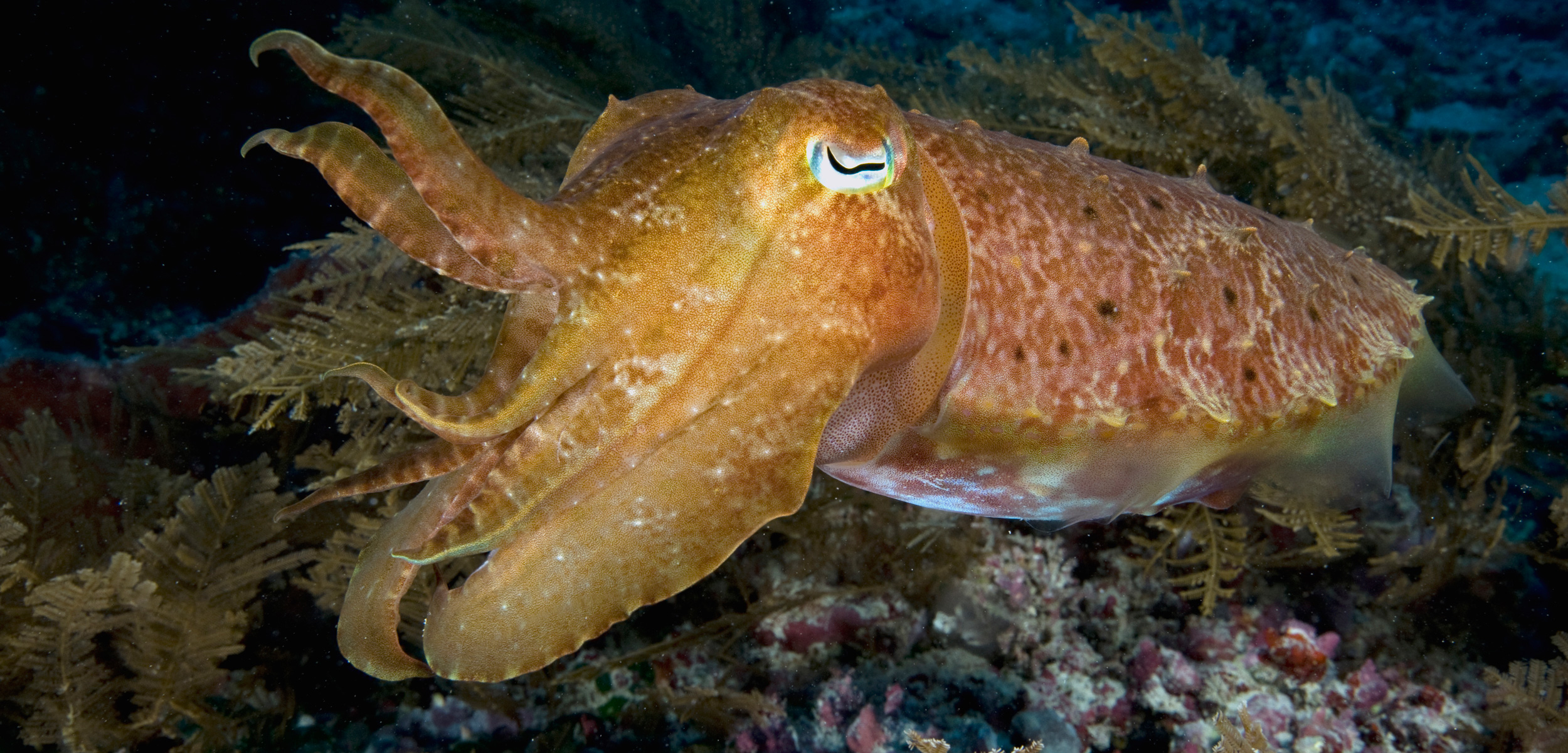This Cuttlefish’s Secret Trick: Pretending to Be a Crab
Cephalopods really are the masters of misdirection.
Article body copy
Kohei Okamoto was caught off guard the first time he saw what appeared to be a cuttlefish doing a hermit crab impersonation. Okamoto, a researcher at the University of the Ryukyus in Okinawa, Japan, was moving 48 lab-raised pharaoh cuttlefish into a large, circular tank to study cuttlefish hunting techniques when three of the animals started flapping their arms intensely—a behavior not displayed when they were living in smaller holding tanks.
The flapping was unrelated to Okamoto’s ongoing project, but it stuck in his mind. So after his planned work was done, Okamoto and his colleagues transferred eight cuttlefish into a big tank, added a GoPro camera, and waited.
The footage was remarkable: on 21 separate occasions over five days, the cuttlefish exhibited the strange behavior. Each time, a cuttlefish would raise its foremost pair of arms, darkening the tips of each, while pointing its second and third pair toward the floor, flapping them as if they were jointed. While making these movements, the cuttlefish would hover close to the bottom of the tank, and rarely venture into the water column. “They seemed like hermit crabs, to me at least,” says Okamoto.
A pharaoh cuttlefish pretends to be a hermit crab, raising its front legs to look like eyestalks and appearing to walk on the bottom of the tank. Video by Japan Ethological Society & Springer Japan
Later, when the researchers were conducting more experiments on cuttlefish hunting, the behavior appeared again. This time, when 33 cuttlefish were presented with fish to prey upon, 16 spontaneously started flapping. Convinced that the arm flapping was a previously unknown behavior, the researchers wrote up their observations in a scientific study. But why would a cuttlefish want to look like a crab?
“Mimicking hermit crabs could be beneficial for the cuttlefish, because hermit crabs have a hard shell to protect them against predators,” Okamoto suggests.
A predator sees a squishy cuttlefish and its tummy rumbles—if it sees a crunchy crab instead, it might rethink its meal. The fact that the animals displayed this odd behavior when introduced to a large, empty tank—an environment without potential prey, but where the cuttlefish might feel exposed and vulnerable to predators—would support such a hypothesis.
Okamoto and his colleagues also think that the crabesque behavior may help the cephalopods sneak up on fish. Since hermit crabs are scavengers that prefer detritus and carcasses to living meals, the cuttlefish’s prey might be tricked by the disguise—allowing the cuttlefish to venture within striking range.
Okamoto and his colleagues found that cuttlefish that make crab-like arm movements catch twice as many fish as their nonflailing brethren. But, they also found that making crabby gestures right before a feeding strike didn’t increase the likelihood of success in that particular attack. Rather, the cuttlefish that mimicked crabs caught more prey overall because they made more attempts. Whether their increased attack rate is related directly to the flapping or not is hard to say, and will require further investigation.
Of course, the cuttlefish could be gaining both the defensive and offensive advantages of playing crab simultaneously. Or, they could not be attempting to mimic crabs at all.
Okamoto emphasizes that just because cuttlefish look like hermit crabs to us doesn’t mean that’s their intent. “The behavior might function as mimicry, but it is still possible that the behavior is used for [camouflage], luring prey, or for other purposes,” he says.
While octopus species (especially the mimic octopus) tend to get all the attention when it comes to cephalopod mimicry, cuttlefish are also well versed in the art of deception.
In 2012, researchers showed how young dwarf cuttlefish seem to mimic snails, for similar reasons posited for the pharaoh cuttlefish. And in Mark Norman’s Cephalopods: A World Guide, he describes how juvenile giant cuttlefish possibly mimic pufferfish.
Intriguingly, only some of the cuttlefish in Okamoto’s study were ever seen displaying the novel behavior. And given that these cuttlefish were collected as eggs and raised in tanks—having never seen a hermit crab—it’s unclear where they would have gotten the idea.
Okamoto’s colleague Ryuta Nakajima is looking further into the mimicry hypothesis, including if or how the behavior is learned. But in the meantime, Okamoto hopes the new finding inspires a little more love for these somewhat alien creatures.
“Cephalopods are amazing animals,” he says. “These [observations] are just a small part of something hidden.”

